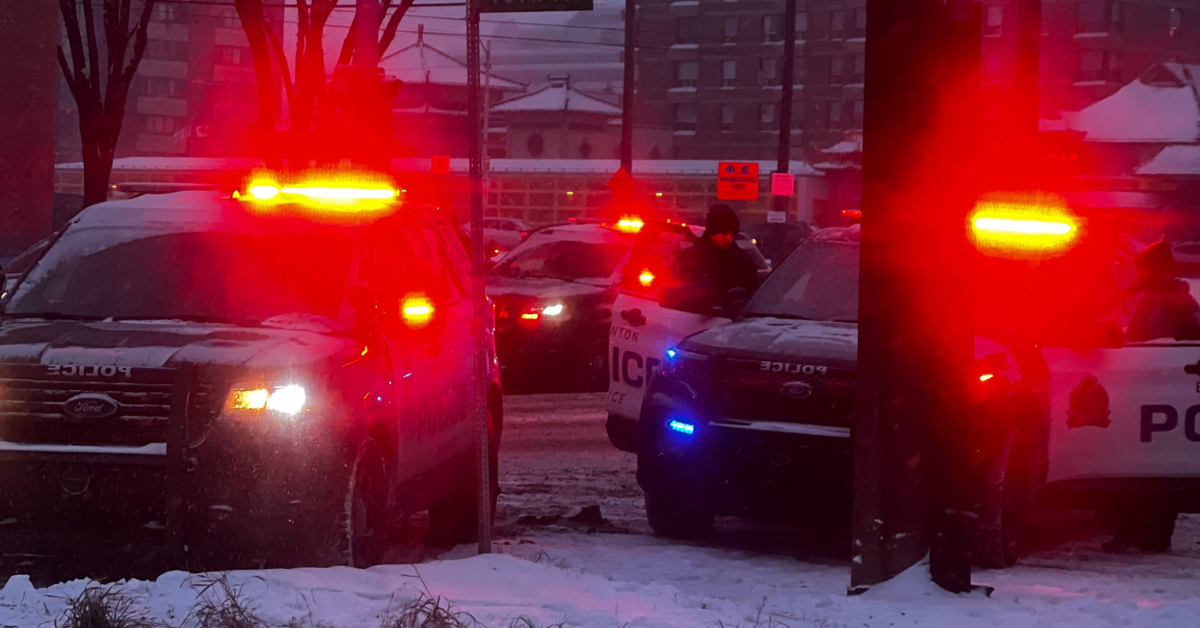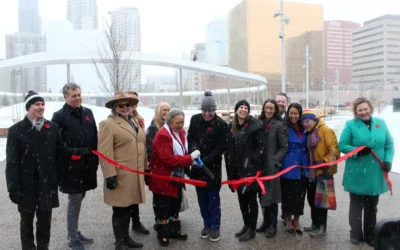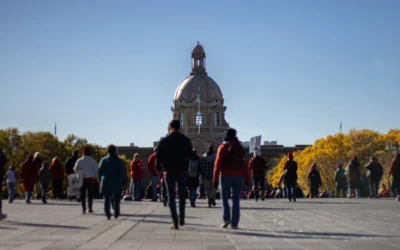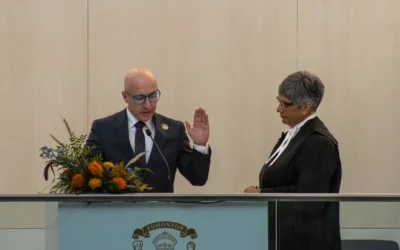Edmonton’s most recent response to Edmonton’s homelessness crisis has been to dismantle the encampments that have been appearing increasingly around the city, especially downtown. The decision has been criticized by many, with community organizers, advocates, activists, and researchers expressing deep concern as they label it more harmful than beneficial.
With the dismantling occurring during the city’s coldest weeks, concern has increased as it leaves people without shelter and does not provide solutions, support, or alternatives. Despite the severity of the issue and the developments in the past few weeks, students know little to no information about the issue. Many MacEwan students state that they didn’t know about the encampments, or only vaguely knew of them. Yet, when asked if they would like to be informed or even involved, most enthusiastically responded “yes.” Students just didn’t know how, which as a response, was fair, considering the lack of extensive or accurate media coverage.
“There are damaged centred narratives of our people that tell a story of trauma, struggle and violence…but, our people are also full of incredible capacity for community, intelligence, and our culture has a lot to teach the western world about living a good life.“
Veronica Fuentes, local Indigenous organizer
Cynthia Puddu, an allied health associate professor at MacEwan, says the actions of the Edmonton Police Service (EPS) have only exacerbated the issue.
Puddu’s past and current research mainly focuses on youth homelessness and the systemic issues perpetuating it. Her research with the social service organizations Action Alliance for Youth Inclusion (AAYI) and M.A.P.S Alberta Capital Region hopes to inform policy to find proper “humane solutions” with the City of Edmonton.
Whether or not that work has been productive is a complicated question. Puddu says there are complexities and factors that play into finding and applying a viable solution, and the layers are extensive and entangled. She says many shelters and not-for-profits that aid those affected by the dismantlings risk their own government funding as well by challenging the decision of a government institution.
When asked why shelters are not a viable alternative, Puddu made it clear that staffing and space are only the tip of the iceberg. Some shelters don’t allow people to stay with their partners or may prohibit substance use, which can be impossible for some. At the same time, some people have a fear of being assaulted or having their belongings stolen. Puddu also spoke about how some shelters are only open for the night, making them temporary solutions. Sometimes, the only solution, as bad as it may seem, is a tent, even in the cold. The complexities have not dissuaded her from her involvement.
Ali Ansari, a young activist in Edmonton, firmly believes that as slow as the progress towards reducing homelessness is, it is happening. Ansari has recently gained on-the-ground experience in his advocacy as he dedicated much of his time answering the call for witnesses at the targeted encampments. He mentioned the importance of continued advocacy and involvement, claiming that the proof of their efforts was felt when their presence at the encampments managed to delay the dismantling by two days. Time which allowed people to “prepare them[selves], to pack their bags, [and for others] to bring them donations…so these folks weren’t left with nothing,” he says. In previous encampments, many personal belongings were seized and thrown away due to insufficient warning of police presence. Some of these belongings include supplies that would have helped people keep themselves safe against the cold. Ansari witnessed the EPS’s way of handling the sweeps. “I watched the police push and shove all of my friends and even violently hit them… it was the most heart-wrenching experience ever,” he recounts. All of this happening in weather reaching -47 C degrees.
“You don’t need to have any specific background to just be loving and caring and want to treat people humanely.“
Cynthia Puddu, assistant professor in the faculty of health and community sudies at MacEwan University
After what Ansari had seen at the sweeps, he attended the City Council meeting discussing whether or not to declare a homelessness emergency. People participated in a walk-out led by Roy “Big Man” Cardinal, leader of one the encampments, before the change was made as the vote passed.
If actions prove to be fruitful, then what has kept people from involvement? The most common answer from student interviews was fear. Puddu mentioned how fear has emerged from the stigmatization of drugs and its users. She emphasizes that drug use as a coping method should be seen for what it is: a disorder. She says, “There are people on this campus that drink alcohol and use cannabis… some students do that because they’ve had a bad day.” She challenges students to “imagine you’ve had a really, really, really bad day, every single day, 24/7.” Puddu says that a shift is needed in how people view the houseless community, especially when many on-the-ground activists have outright rejected the perpetuation that houseless people are dangerous.
“If we’re fighting for crumbs, then so be it…crumbs [are] better than thin air.”
Ali Ansari, student activist
Ansari says, “They’re not dangerous people… they’re not just going to randomly attack you on the street. Anyone who’s doing that has other issues going on, but it’s not because they’re houseless that they are attacking you.”
“How much violence do we see from people who live in houses?”
Ansari wants people to know that “when you walk into those tents, it is set up like a home… they do a good job at providing themselves with the dignity that the rest of society fails to provide them with.”
Another activist and Indigenous organizer, Veronica Fuentes, feels the same way. “I have personally never felt unsafe… we socialized into fearing unhoused people, which is how the City of Edmonton and EPS can get away with criminalizing them, harming them, banishing them from areas of the city, et cetera,” Fuentes says. She provides further context based on her extensive work in the inner city and involvement in mutual aid efforts, specifically her work in the “intersectional and dynamic issues within Indigenous advocacies.” She says, “People who are entrenched face a lot of violence… I actually often argue that community members who live outside face incredible safety concerns that the city and EPS don’t want people to take seriously.”
“Community members are not just inherently dangerous by nature of living outside.”
Veronica Fuentes, local Indigenous organizer
In separate conversations with Puddu and Fuentes, the statistics regarding the unhoused community were discussed. 5.8 per cent of Edmonton’s population is Indigenous. However, they make up 54 per cent of the city’s unhoused population. Fuentes believes that Indigenous struggles surrounding houselessness are a part of colonial erasure of indigenous people. She argues that the current displacement of Indigenous people “is mirroring what has happened to [their] ancestors for hundreds of years.”
“…Our people are literally dying faster than anybody else for reasons deeply tied to the racialized poverty our communities face.”
Puddu brings up the overrepresentation of Indigenous children in the foster care system and states, “young people in foster care are at higher risk of becoming unhoused.” She explains that the overrepresentation is due to “[this] settler-colonial attitude that Indigenous families don’t know how to parent their children.” She says that displacement of Indigenous people is “not quite an act of reconciliation.”
Fuentes argues that “affordable housing isn’t the only answer” but rather, a focus needs to be put on “child welfare, resource extraction, missing and murdered Indigenous women and girls, the drug poisoning crisis, homelessness, et cetera.”
“There are damaged centred narratives of our people that tell a story of trauma, struggle and violence…but our people are also full of incredible capacity for community, intelligence and our culture has a lot to teach the western world about living a good life.“
Veronica Fuentes, local Indigenous organizer
Like many local and global issues, a struggle emerges when people begin to inform themselves. One question arises: What can I do? Ansari urges people to “get out there.” He encourages people to get involved, whether that is by going to City Council meetings or participating in a clothing drive. “The more you volunteer in these spaces, the more people you will meet that have those answers for you,” Ansari says. He also says that putting pressure on representatives and public officials is necessary and available. This can be done through many means: email, phone, or going to their offices and demanding a meeting. Both Ansari and Fuentes emphasize the importance of attending rallies, staying informed, and recommending platforms like Tawâw Outreach Collective, 4B Harm Reduction, Bear Clan Patrol, Nék̓em, and Free Together YEG. Fuentes says, “Sometimes the best support for community comes directly from outreach efforts and donating to these groups.”
Puddu recognizes that on-the-ground work doesn’t always appeal to everyone. Remaining informed and aware of one’s mentalities when approaching this social issue is essential. Humanizing unhoused people may not solve the problem, but she firmly believes it’s crucial for progress. She also recommends getting involved with community services like Boyle Street Community Services or donation drives. At the end of the semester, Puddu and her classes provide education seminars and a donation drive for Boyle Street Community Services. MacEwan students are also encouraged to use the resources in the kihêw waciston Indigenous Centre when seeking information.
Photo credits: Ali Ansari





Great article thanks for highlighting the issue is such a professional way
Great job
Very well written! I’m probably among those students who know little to none about encampments but this has definitely opened up my eyes.
amazing and insightful article!!
hope things change
This article was Amazing and beneficial to all thank you for spreading the awareness
This article was helpful thanks for opening our eyes to it